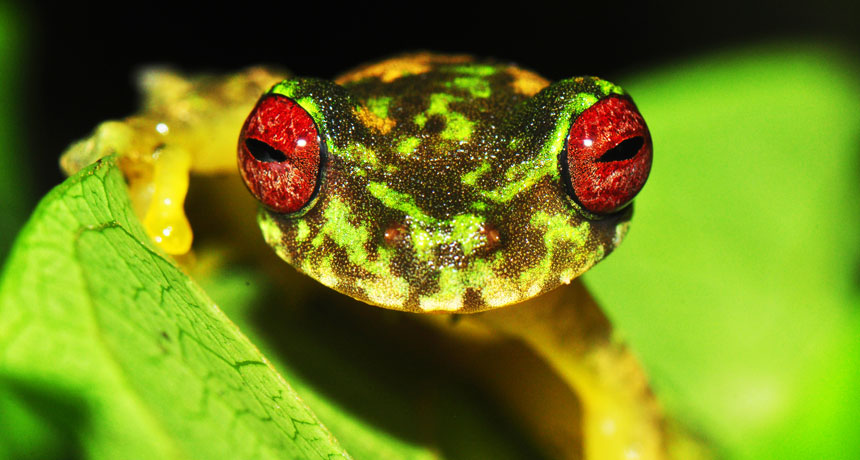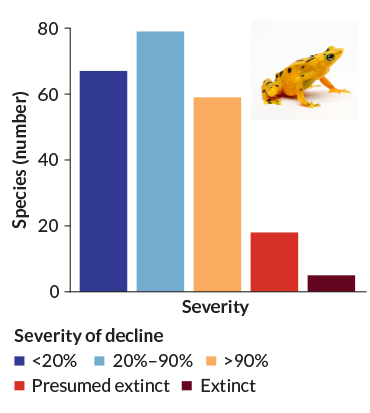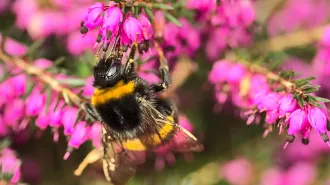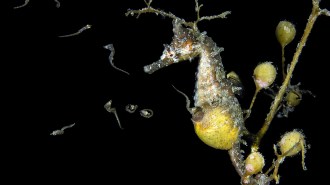Chytrid’s frog-killing toll has been tallied — and it’s bad
The invasive fungus has devastated more species than have cats and rats

UNDER THREAT Endangered mossy red-eyed frogs (Duellmanohyla soralia), like this one from Honduras, are among at least 500 amphibian species whose numbers have declined due to chytrid fungal infections, a new tally shows.
Jonathan E. Kolby/ Honduras Amphibian Rescue & Conservation Center
- More than 2 years ago
A skin fungus that has plagued frogs and toads worldwide now holds the title of being the world’s worst invasive killer, displacing cats and rodents.
The first global tally of the toll caused by a chytrid infection shows that it’s responsible for population declines in at least 500 amphibian species, including 90 presumed extinctions. And that’s a conservative estimate, scientists say. The affected animals, mostly frogs and toads, account for 6.5 percent of known amphibian species, making the pandemic “the greatest documented loss of biodiversity attributable to a pathogen,” researchers report in the March 29 Science. (In comparison, cats threaten 430 species and rodents, 420 species.)
Batrachochytrium dendrobatidis or Bd for short, a pathogen that’s been widely spread by wildlife trade, is the primary culprit. Bd, first identified in 1998, has caused massive frog and toad die-offs. Though the scourge peaked in the 1980s in Central and South America and Australia, it remains an ongoing threat.
The fungus infects the keratinized skin that amphibians develop once they mature and transition from water to land. The resulting chytridiomycosis destroys an amphibian’s ability to regulate the proper flow of electrolytes and fluids through its skin, usually leading to heart failure within a few weeks.
Ben Scheele, an ecologist at Australian National University in Canberra, coordinated 40 other researchers with regional amphibian knowledge. The team analyzed published literature and unpublished data, including interviews of researchers with expertise in 24 countries known to have chytrid infections. In an epidemiological analysis, the researchers integrated the data to determine the severity, timing and geographic distribution of amphibian declines due to chytridiomycosis.
Of the 500 affected species, about 40 percent are still declining. And the populations of 124 species — or 25 percent — have dwindled to less than 10 percent of their previous numbers. Hardest hit have been large, slow-growing species that don’t reach reproductive maturity as quickly, species living in wetter areas (which the fungus prefers) or at higher altitudes (where animals are more isolated and have fewer habitat choices). Among the extinct in the wild or presumed extinct: the golden toad, the Panamanian golden frog and the Angelito stubfoot toad. A second related fungus, B. salamandrivorans or Bsal, primarily affects salamanders and was responsible for the decline of one species.
Hardest hit
The region that includes Central America, Mexico and the Caribbean Islands has had the most declines worldwide in amphibian species as a result of chytrid fungal infections.
Amphibian declines due to chytrid fungus in Mesoamerica


Only 12 percent of species show some limited signs of recovery (SN Online: 3/28/18), the team found. Those amphibians may be evolving immunity, or other threats – such as habitat loss or pollution – may have waned, the researchers say.
The results, while not surprising, are “sad,” Scheele says, and the reality may be even worse. The fungus has probably affected many of the yet unnamed amphibian species in the neotropics, and for other declining species, there was not enough evidence linking their dropping numbers to chytridiomycosis.
Doing an analysis like this is challenging, but important, says Allan Pessier, a veterinary pathologist at Washington State University in Pullman who helped first identify Bd in amphibians. “There is a lot of information about individual species out there, but no one had brought it all together. I’m really happy that they were able to draw conclusions out of this” that may help conservation efforts, he says.
Bd remains “a very serious threat,” says Scheele, especially to unexposed amphibian populations, such as those in Papua New Guinea. And, with the global spread of pathogens, new strains of the fungus can continue to evolve, outpacing species’ abilities to adapt. Once loose in the environment, the only way to contain it is through better biosecurity measures and improved wildlife monitoring, he says.







